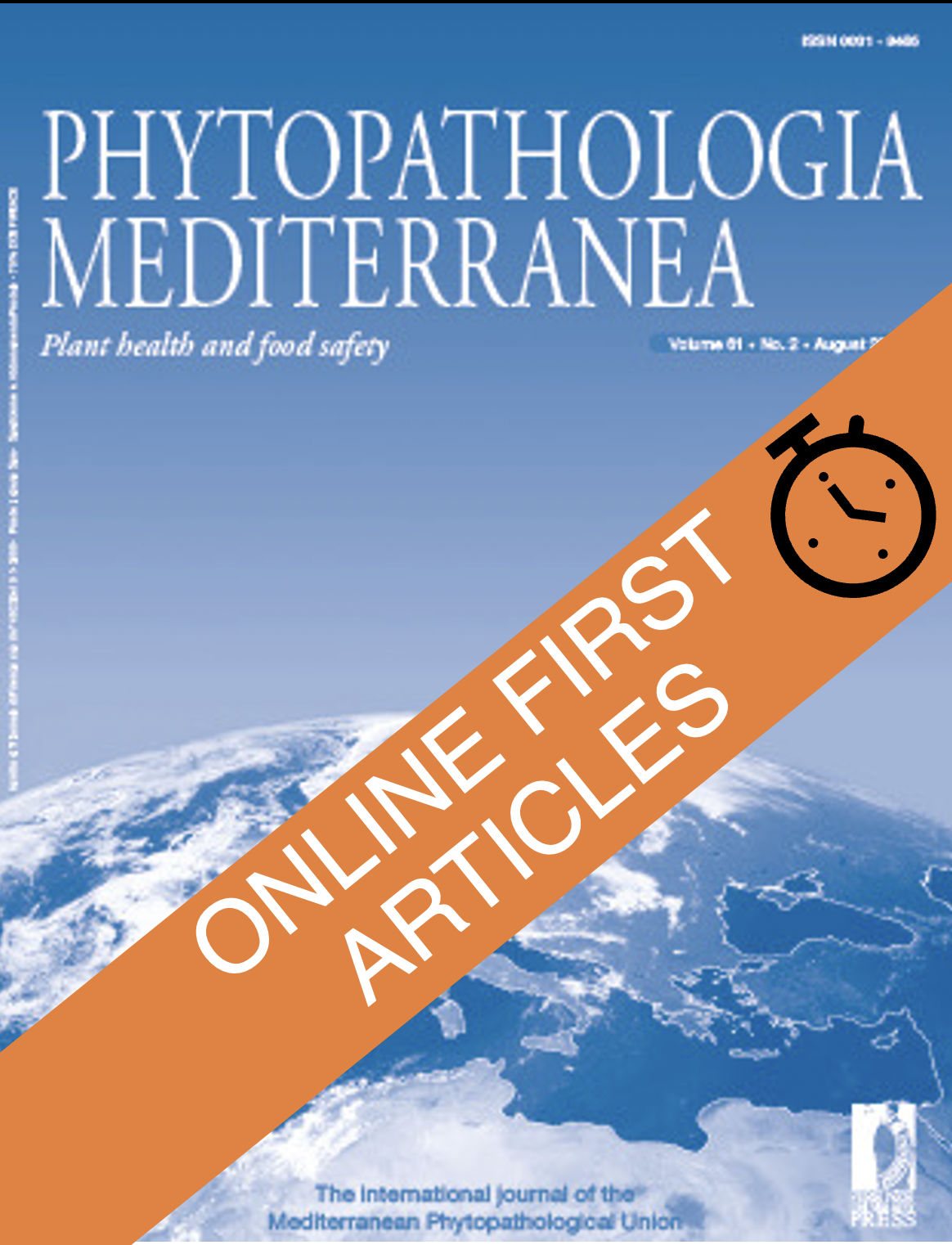Published 2024-02-17
Keywords
- Fig,
- mosaic disease,
- viruses,
- detection,
- phylogenetic analyses
How to Cite
Copyright (c) 2024 Eduviges Glenda BORROTO FERNANDEZ, Toufic ELBEAINO, Florian FÜRNSINN, Anna KEUTGEN, Norbert KEUTGEN, Margit LAIMER

This work is licensed under a Creative Commons Attribution 4.0 International License.
Abstract
Ficus carica is one of the most ancient cultivated crops, and is grown mainly in the Mediterranean region. In Austria, due to milder winters and longer warm periods than normal, figs are becoming more productive and popular among private growers. For future propagation of some fig varieties, the phytosanitary status of eight fig accessions, representing four Austrian genotypes maintained in a varietal collection plot, was investigated using PCR assays for presence of eight fig-infecting viruses. The four fig trees were infected with fig mosaic virus (FMV), fig badnavirus 1 (FBV-1), fig leaf mottle-associated virus 1 (FLMaV-1), fig mild mottle-associated virus (FMMaV) and fig fleck-associated virus (FFkaV); whereas fig leaf mottle-associated virus 2 (FLMaV-2), fig latent virus 1 (FLV-1) and fig cryptic virus 1 (FCV-1) were not detected. The sequences of PCR amplicons obtained from different viruses and samples showed greatest nucleotide variability of 0.5% for FBV-1, 12% for FLMaV-1, 16.3% for FMV, 14% for FMMaV, and 15% for FFkaV, when compared to their homologues in GenBank. A phylogenetic tree for FMV constructed based on partial RNA1 sequences showed that the Austrian isolates were most closely related to previously described Spanish and Greek isolates. The different symptoms observed in the tested trees were mainly in similar to with those reported for FMV, the agent of fig mosaic disease. This is the first report on the presence of fig mosaic-associated viruses in Austria.
Downloads
Metrics
References
- Alsaheli Z., Contaldo N., Mehle N., Dermastia M., Elbeaino T., Bertaccini A., 2020. First detection of “Candidatus Phytoplasma asteris”‐and “Candidatus Phytoplasma solani”‐related strains in fig trees. Journal of Phytopathology 168(1): 63-71. DOI: https://doi.org/10.1111/jph.12868
- Altschul S.F., Stephen F., Gish W., Miller W., Myers E.W., Lipman D.J., 1990. Basic local alignment search tool. Journal of Molecular Biology 215: 403–410. DOI: https://doi.org/10.1016/S0022-2836(05)80360-2
- Condit I.J. 1933. A mosaic of the fig in California. Phytopathology 23: 887–896.
- Elbeaino T., 2022. Fig Pathogens: Viruses, Viroids, and Phytoplasmas. In: Advances in Fig Research and Sustainable Production (pp. 279–292). GB: CABI. DOI: https://doi.org/10.1079/9781789242492.0016
- Elbeaino T., Digiaro M., de Stradis A., Martelli G.P., 2006. Partial characterization of a Closterovirus associated with a chlorotic mottling of fig. Journal of Plant Pathology 88: 187–192.
- Elbeaino T., Digiaro M., De Stradis A., Martelli G.P., 2007. Identification of a second member of the family Closteroviridae in mosaic-diseased figs. Journal of Plant Pathology 89: 199–124.
- Elbeaino T., Digiaro M., Alabdullah A., De Stradis A., Minafra A., … Martelli G.P., 2009. A multipartite single-stranded negative-sense RNA virus is the putative agent of fig mosaic disease. Journal of General Virology 90: 1–8. DOI: https://doi.org/10.1099/vir.0.008649-0
- Elbeaino T., Digiaro M., Heinoun K., De Stradis A., Martelli G.P., 2010. Fig mild mottle-associated virus, a novel closterovirus infecting fig. Journal of Plant Pathology 92: 165–172.
- Elbeaino, T., Kubaa R.A., Digiaro M., Minafra A., Martelli G.P., 2011a. The complete nucleotide sequence and genome organization of Fig cryptic virus, a novel bipartite dsRNA virus infecting fig, widely distributed in the Mediterranean basin. Virus Genes 42: 415–421. DOI: https://doi.org/10.1007/s11262-011-0581-0
- Elbeaino T., Digiaro M., Martelli G.P., 2011b. Complete nucleotide sequence of Fig fleck-associated virus, a novel member of the family Tymoviridae. Virus Research 16: 198–202. DOI: https://doi.org/10.1016/j.virusres.2011.07.022
- FAO, 2019. http://www.fao.org/faostat/en/#rankings/countries_by_commodity. Accessed 23 July 2020. Food and Agriculture Organization of the United Nations, Rome, Italy
- Gattoni G., Minafra A., Castellano M.A., De Stradis A., Boscia D., … Martelli G.P., 2009. Some properties of Fig latent virus 1, a new member of the family Flexiviridae. Journal of Plant Pathology 91: 555–564.
- Kislev M.E., Hartmann A., Bar-Yosef O., 2006. Early domesticated fig in the Jordan Valley. Science 312(5778): 1372–1374. DOI: https://doi.org/10.1126/science.1125910
- Laney A.G., Mohamed H., Ioannis E.T., 2012. An integrated badnavirus is prevalent in fig germplasm. Phytopathology 102: 1182–1189. https://doi.org/10.1094/phyto-12-11-0351 DOI: https://doi.org/10.1094/PHYTO-12-11-0351
- Seiler C., 2022. Feigen aus dem eigenen Garten: Über 30 leckere Sorten, die sich selbst befruchten. Ulmer, Stuttgart, Germany, 128 pp.






